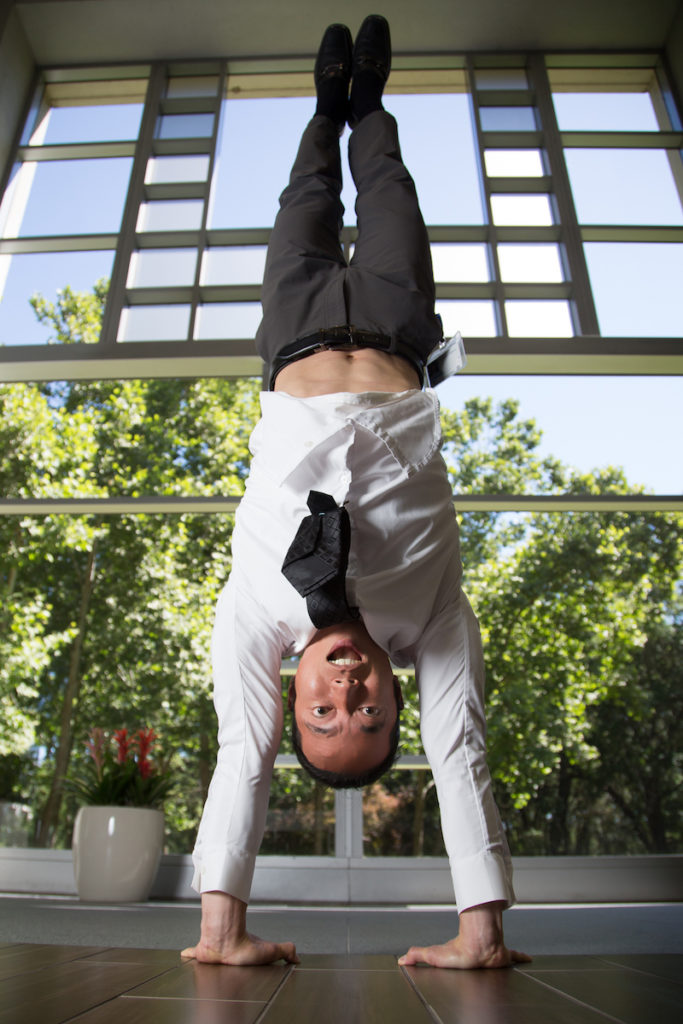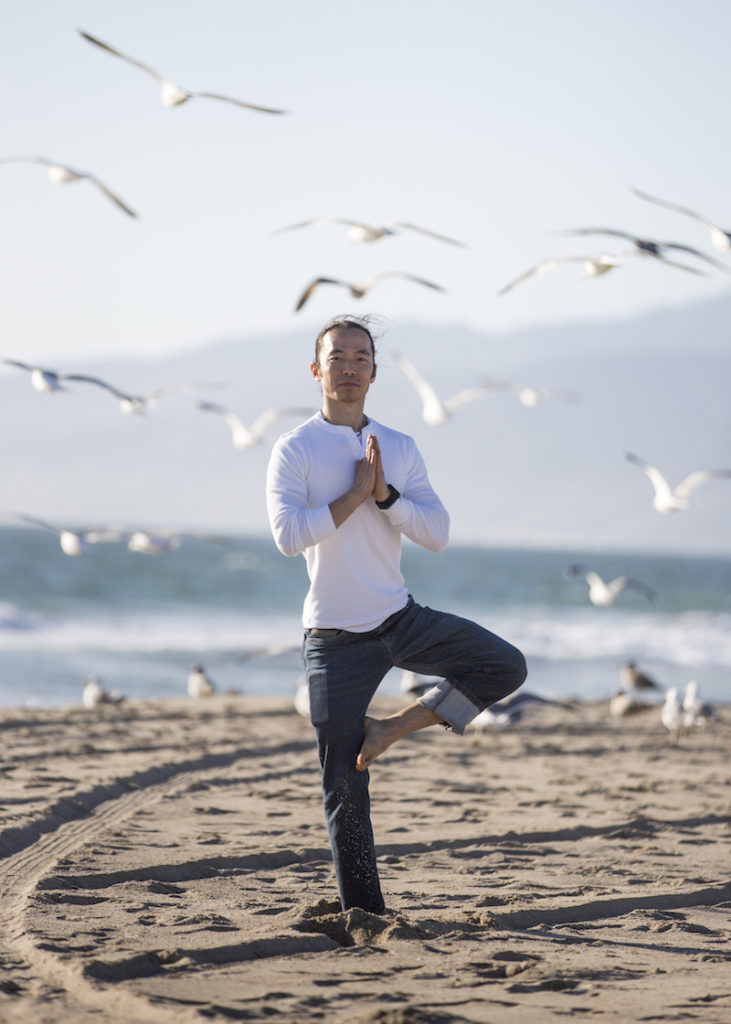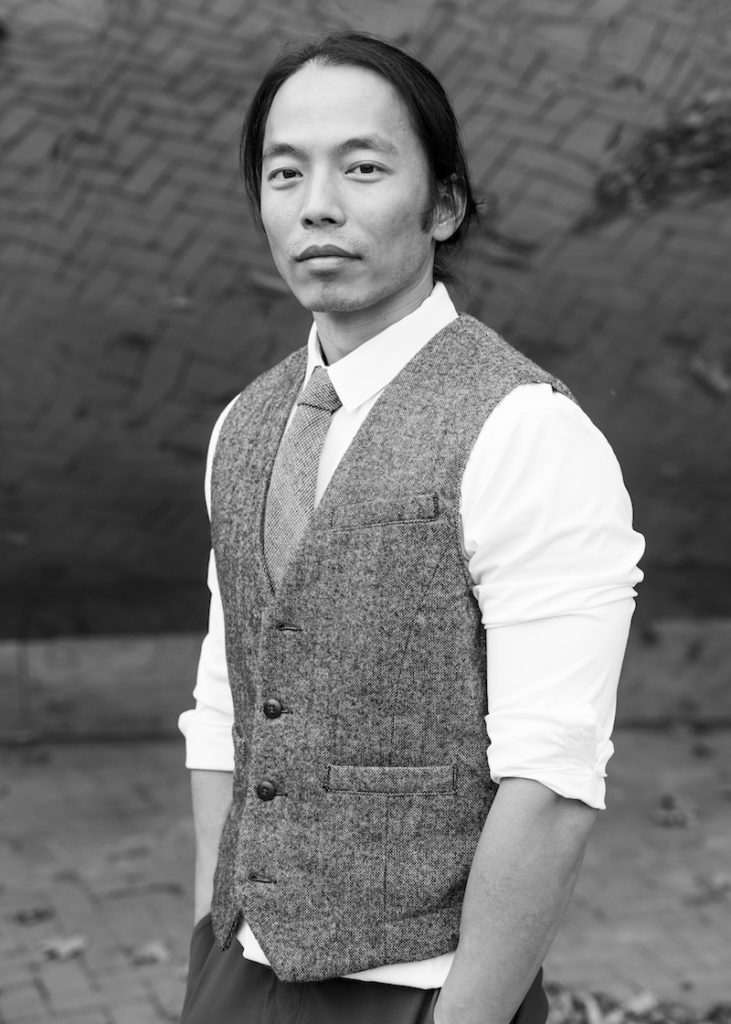You are here at Sacramento Pipeworks…listen closely and your will hear the voice of Siawn. It’s usually from high atop the climbing wall, or upside down in a handstand near the stretch mats. Wherever the case, it is a very distinctive voice, and the language can sometimes be peppered with naughty words. Don’t let these words fool you! There is a certain wisdom and focus behind this man that take us well beyond his years. However you choose to relax, either sit down or stand on your hands, but take a few moments to get a glimpse into the mind of Siawn Ou.
Can you please tell us what The Pursuit of Movement is and why you believe it is important for us, as humans, to stay in motion?
The Pursuit of Movement, in short, was my way of saying “I’m not too old yet for this shit!”
Everyone at some point will feel like they are passing their prime, and that moment hit me as I entered my 30s. In adulthood, hobbies like breakdancing started feeling tedious to maintain. Thinking that I could no longer improve, I stopped moving altogether.
I made it six months. Around my 31st birthday I came across a video with movement icon Ido Portal. He said that we didn’t need a reason to move. We move because we can. He goes on to perform a wide range of physical feats that left me mesmerized. “That looks very freeing,” I thought. And I was curious to see if I could experience that kind of freedom myself.
I’ve been pursuing movement ever since. This initial challenge of learning physical feats has evolved into a lifestyle that shaped my confidence and self-understanding. I’ve been exposed to a spectrum of movement arts, immersed myself in different subcultures, and trained with very talented people. I’ve even been able to give back by talking about my movement experience in a TED Talk.
I think we need to move because it’s how we best understand ourselves physically. You never truly know who you are unless there’s a physical thing you can do to verify it. Movement gives you that discovery, and moreover, the opportunity to create who you want to be.
Nowadays, it sometimes feels like we are living in an upside down world. Spending lots of time doing backflips and headstands, does this make your perspective different?
You’ve never truly seen the sky until you’ve seen it upside down. The next time you’re at the beach, do a headstand and gaze out at the ocean. Infinity in front and at your feet, you feel like you will fall forever.
Movement really gives you a level of interaction with your environment that you can’t get any other way. Touching the ground, spotting a tree while mid-flip, pressing your hips closer to a wall as you reach for the next hold…it’s all very intimate. This tactile and kinesthetic relationship enhances all your other senses, and makes you experience your surroundings in a whole different way.
Your workouts contain elements of breakdancing, capoeira, gymnastics, and dance. As of fairly recently, you have incorporated climbing into the mix. Was it easy to learn these new skills since you already had a good understanding of your body?
Legendary swordsman Miyamoto Musashi once said, “If you know the way broadly, you will see it in everything.” I think this is very relevant to movement and spans across all its disciplines, climbing included. Having trained in other practices definitely gave me an advantage on the wall.
There are moments on a climb when I do a very “bro” move, and then think to myself, “Wow, thank God I’m strong.” It’s actually not a statement of pride for I’d much rather have good technique and avoid wasting energy. I’m just grateful for coming into climbing with strength and awareness I can count on during those not-so-graceful moments.
The juxtaposition of your active playful spirit and fiercely rigid training side seem to have found a common middle ground in your 30s. What sorts of activities lay ahead in your quest to remain spry and nimble into old age?
I feel like different movement activities come into my life when they are supposed to. Climbing was not something I intended to pursue when I joined Pipeworks (who joins a climbing gym to climb?), but five months into my membership an injury from acrobatics made me stop one thing and start climbing again. I guess I needed to learn the lessons that only the wall could teach me.
I’ll keep that openness going into the future. I would love to stay active in climbing and acrobatics until I’m an old man, but I’ll refrain from being so stubborn as to plan my life around those activities. I’m down to explore whatever comes up. Dance and martial arts seem pretty interesting…
Have you had any personal experience with parkour or freerunning?
I took a parkour class once. I was the only adult in a group of 8-year-olds and we all had matching Feiyue shoes. It was adorable.
There’s a parkour documentary called People in Motion that I encourage everyone to watch. It really opened my eyes to the emotional content and mindset behind the practice.
You traveled to Boston in 2015 to give “the performance of (your) life.” During this Ted Talk, you spoke of overcoming fear and weighing risk and reward in everyday decisions. Climbing definitely deals with these factors as well. Did you choose this sport because of these similarities?
Initially no. I started climbing again because it was fun and my body adapted to it well. I didn’t start to really think about the mental aspects of climbing until around nine months in. I was leading at a decent enough grade to where I could partner up with some of the stronger climbers in the gym. Climbing with people better than you is a real motivator, and I started going beyond the physical and exploring the cognitive side of the sport.
There are two things that really changed how I looked at climbing. One was the book The Rise of Superman by Steven Kotler. It talks about flow states through the lens of action adventure athletes, and decodes how to reach that level of absolute focus and performance. The second thing was climbing outdoors. There’s a perfect combination of environment, novelty, and fear that comes with real rock. This recipe along with knowledge from the book allowed me to recognize when I was in flow, and all this began to influence how I approached challenges and maximized my training.

After a summer in Shanghai studying the art of pool playing under a master teacher, what made you change your mind about pursuing this as a career and becoming the next Efren Reyes?
Wow, you really dug deep through the archives!
Pool was my first real passion, and I devoted five years to it with the intention of becoming a pro. This was where I developed all of my discipline, determination, and ability to deal with failure.
What changed my mind about pursuing pool was spending a nice day outdoors in Maine. Very ordinary I know, but also very eye-opening. I realized how much I was missing out by confining most of my life and development to within just a pool hall. Letting go of the game was a difficult thing to cope with. I felt as if I were losing a part of my identity. But I eventually discovered that it was my passion for things, and not the things themselves, that made up my identity. I was going to have it wherever I went, and I could apply it to whatever I wanted to.
The passion you have for all of your personal interests is quite evident to most onlookers. What advice would you give to those curious about ways to change their course of action toward that of a more creative and rewarding life?
There’s an old Zen saying that goes “Better to not begin. Once begun, had better finish.” I think the challenge for anyone looking to make a lifestyle change is not the start, but rather keeping with it. Passion is something easy to spark but difficult to sustain. Luckily, I’ve found a few things that have helped make the journey enjoyable.
Fun – nothing can ever become a true passion if you don’t enjoy it. Do the things that you like, and remember not to take yourself too seriously. If your passion starts feeling like a chore, think back to what initially drew you in. Keep your training diverse and playful.
Faith – because there will be lulls in your progress. Remember, anything worth doing takes time. As long as you show up, train smart, and reflect honestly, you will improve. Have faith in the process.
Humility – this is the most important lesson, because your ego is the ultimate obstacle between you and mastering your craft. Be humble—respect the art, train with people better than you, address your weaknesses—and you will keep the doors open to growth.
Who are your mentors, heroes, or those you look up to most? Why?
Living
Neil deGrasse Tyson – an intelligent, articulate, and passionate man. His enthusiasm for science is contagious, and the way he presents his thoughts leaves us all reflecting on the bigger picture.
Joe Hisaishi – an incredible musician and masterful storyteller. The first time I heard his music in Spirited Away, I decided I was going to start playing piano.
Ido Portal – a man viewed as talented, charismatic, and controversial. He’s the face of movement culture and has inspired thousands to move, including myself.
Dead
Bruce Lee – a legend, icon, and pioneer. He broke so many boundaries and was way ahead of his time. A Taoist by nature, his philosophy of Jeet Kun Do is still embraced to this day by people of all backgrounds.
Robin Williams – a true genius of his craft with a mind so quick that you could hardly keep up. He delivered some of the most powerful and heartfelt lines as Sean Maguire, my favorite character in Good Will Hunting.
Fictional
Count of Monte Cristo (book version) – just an ordinary guy who went through an incredible amount of suffering and ended up extraordinary.
Tyler Durden – a constant reminder that we are all repressing the person that we want to be. Let go of your control!
Tell us something that most people would not know about you or would be too afraid to ask.
I love interior design. HGTV is my jam.




